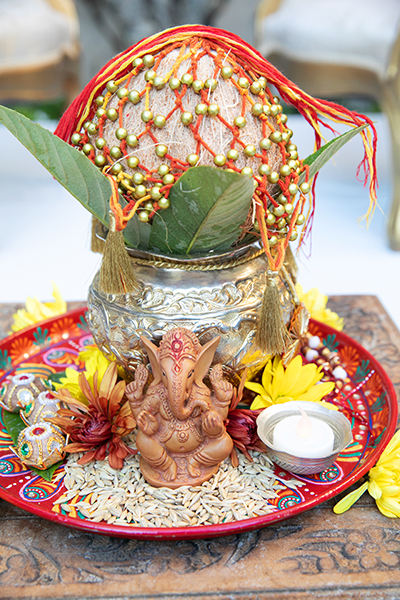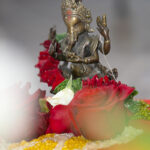 Gujarati Wedding ceremony is an intricate weave of Vedic scripture, folklore, and family traditions. Though the ceremony itself is solemn as it commemorates marriage, one of the sixteen sacraments, the occasion is joyous, colorful, and festive as family and friends gather to celebrate this sacred rite. It is householder stage where in man and woman unites to become husband and wife to assist each other in performance of their religious and social duties. It is not meant to satisfy individual physical needs but is regarded as a means to spiritual glory, a necessity to develop lineage a necessary link between dead past and unborn future that must come alive. It is a lifelong commitment of one husband and one wife. Here if you make sacrifice it is not towards and individual it is sacrifice to the permanent relationship. It is a partnership between two souls who have been put on earth to pursue an ideal life of Nobility, Virtue, Righteousness, and Divine Perfection. During the ceremony, the priest chants Sanskrit mantras set in writing more than 35 centuries ago. These wedding vows unite the bride and groom’s two souls so soundly, that after marriage though their bodies remain as two, their souls merge and unite harmoniously as one. Further, this ceremony not only unites Bride and Groom, but ties their two families together for generations to come. Most importantly the Groom is in the form of Lord Vishnu the preserver of Universe and Bride in the form of Goddess Laxmi the Goddess of Fortune. Each natural substance used by the priest during the ceremony has a unique significance:
Gujarati Wedding ceremony is an intricate weave of Vedic scripture, folklore, and family traditions. Though the ceremony itself is solemn as it commemorates marriage, one of the sixteen sacraments, the occasion is joyous, colorful, and festive as family and friends gather to celebrate this sacred rite. It is householder stage where in man and woman unites to become husband and wife to assist each other in performance of their religious and social duties. It is not meant to satisfy individual physical needs but is regarded as a means to spiritual glory, a necessity to develop lineage a necessary link between dead past and unborn future that must come alive. It is a lifelong commitment of one husband and one wife. Here if you make sacrifice it is not towards and individual it is sacrifice to the permanent relationship. It is a partnership between two souls who have been put on earth to pursue an ideal life of Nobility, Virtue, Righteousness, and Divine Perfection. During the ceremony, the priest chants Sanskrit mantras set in writing more than 35 centuries ago. These wedding vows unite the bride and groom’s two souls so soundly, that after marriage though their bodies remain as two, their souls merge and unite harmoniously as one. Further, this ceremony not only unites Bride and Groom, but ties their two families together for generations to come. Most importantly the Groom is in the form of Lord Vishnu the preserver of Universe and Bride in the form of Goddess Laxmi the Goddess of Fortune. Each natural substance used by the priest during the ceremony has a unique significance:
Fresh flowers – happiness
Coconut – the soul
Betel nut – wealth and happiness
Rice & other grains – sustenance, fertility, and longevity
Water – life energy and purity
Fire – knowledge and purity; the Celestial witness
Ghee (clarified butter) – abundance and purity
To perform a puja, various items are typically used. The specific items may vary based on the purpose, tradition, and personal preference. Here are some common items used in a puja:

This is a kalasha
Idol or Image: A representation of the deity being worshipped, such as a statue, picture, or symbol.
Incense (Dhoop): Fragrant incense sticks or cones are lit to create a pleasant aroma and purify the surroundings.
Diya or Lamp: A small oil lamp or candle is lit to symbolize the presence of divine light.
Flowers (Pushpa): Fresh flowers, especially marigolds and roses, are offered to the deity as a sign of devotion and beauty.
Fruit (Phala): Fresh fruits, usually considered auspicious, are offered as a symbol of abundance and nourishment.
Prasad: Food or sweets offered to the deity are considered blessed and are distributed as prasad to the devotees.
Water (Jal): Water is used to cleanse the deity’s image and is offered in a small vessel or container.
Bell (Ghanta): A bell is rung during the puja to invoke the presence of the deity and create a divine atmosphere.
Kumkum and Turmeric (Haldi-Kumkum): These are often applied to the forehead or the deity’s image as a mark of blessing and auspiciousness.
Sacred Thread (Mauli or Raksha): A sacred thread is tied on the wrist or offered to the deity as a symbol of protection and blessing.
Puja Thali: A decorative plate or tray used to hold the puja items and offerings.
These are some common items used in a puja, but the actual list may vary depending on the specific puja or regional customs. Additionally, a puja may involve recitation of prayers, hymns, or mantras specific to the deity being worshipped performed by a hindu priest.
For more inspiration visit our Indian wedding magazine, Mandala Weddings Magazine!Mandala Weddings Magazine







